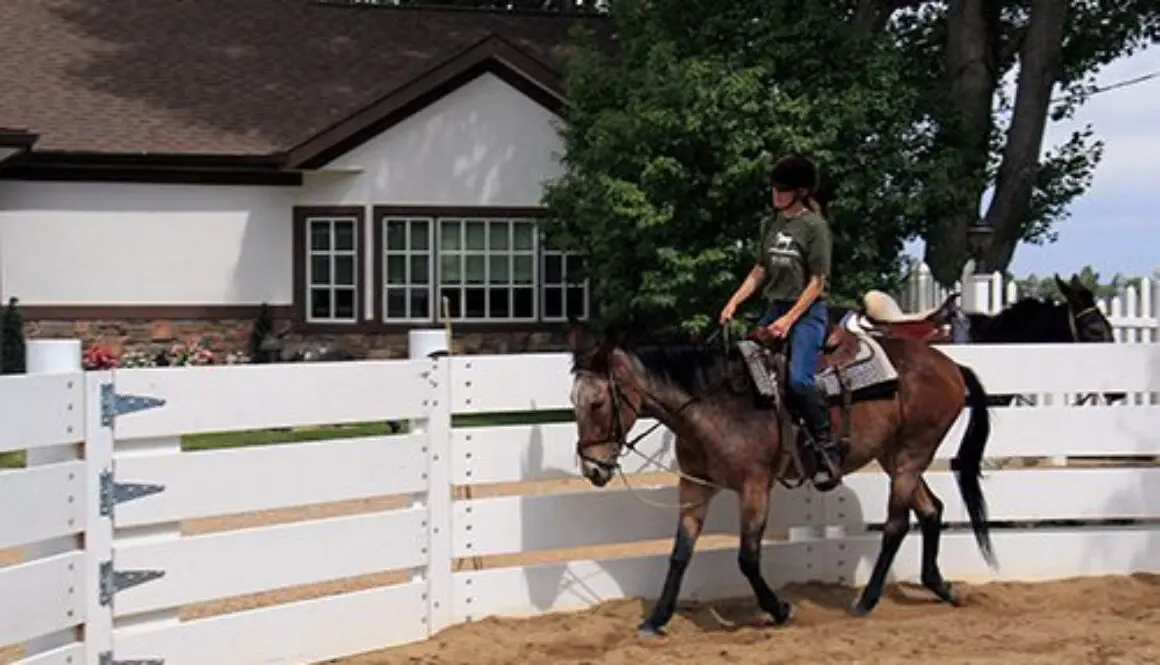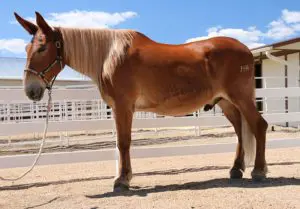By Meredith Hodges
Whether you just want to use your equine for pleasure riding or for show, the way your equine should be managed is still the same. He still needs to be fed, managed and trained correctly for optimum health and performance in order to be a safe, happy and healthy companion. What you do with him each and every day lays the foundation for future challenges. When he is schooled in a logical and sequential way that allows muscles to be slowly and symmetrically strengthened in good equine posture, he will feel better overall than the equine that is not schooled this way. He will not only be able to do tasks safely and more easily, but will actually be happy and have fun engaging with you. The incidence of resistant behaviors becomes practically non-existent. Taking shortcuts with training will never produce the trust and confidence of an equine that is logically and sequentially schooled.

Even pleasure riding produces physical challenges.

Balance in good posture separates the winners from the rest at shows and other public events.

Encouraging good manners and offering the food reward of oats will begin positive negotiation with your equine right from the beginning. He will eagerly learn to look forward to his time with you.

The food reward assures that good behaviors will be repeated and your consistency in routine will transform the equine into one that remains calm, that will ultimately stand quietly upon request.

Being promptly rewarded for confidence and bravery during the execution of fearful tasks such as negotiating obstacles will begin to lay a foundation of trust between you.

When your equine trusts your judgment, trail loading and similar tasks are no problem at all. He will follow you anywhere, anytime…even in stormy weather!

Teaching your equine to execute gates the same way every time results in learned behavior

…the halter and lead rope become incidental.

He will always go through and turn back to you for his reward and can then be easily haltered outside of the pen or easily caught anywhere, anytime.

When you need to lead teams, they will all learn to negotiate the gate the same way.

Even multiple animals will still exit the gate, turn to you and wait for their halters and rewards.

Practicing showmanship techniques as a matter of course and not just reserving it for a show, gives leading a purpose that your equine can easily understand. It begins to develop strength in good equine posture that makes him comfortable in his body.

Standing still while mounting is never a problem when your equine is properly prepared and knows what to expect. The anxiety that causes movement is no longer present.

Carefully planned and controlled exercises in the round pen with the “Elbow Pull” gives your equine the freedom to move in good posture with a passive support system. It will help him to hold that posture for more than a few strides at a time. It gives muscles the time to be properly conditioned in good posture before the rider is ever introduced.

When the rider is finally introduced, he is strong enough in his own ideal posture to be able to sustain his balance while dealing with any shifts of balance from an inexperienced rider or variations of terrain.

When your equine has had ample leading training for good equine posture, it is easy to make the transition to ground driving in good posture, whether driving single or with teams…

…large or small, your equines will be in sync with you, and with each other. They can easily learn to pull evenly, stop squarely and stand quietly.

Learning to negotiate obstacles correctly and in good equine posture aids in symmetrical muscle development and the ability to stand balanced and comfortable in a variety of postures…

…this makes it much easier for handling by the veterinarian and farrier, and during practical applications such as taking x-rays from blocks.

Learning to stand off the end of a bridge during leading training exposes how unbalanced most equines really are until they learn how to negotiate these kinds of strengthening and balancing exercises. No mammal is automatically born in good posture. It must be taught.

When it IS taught, standing on the x-ray blocks behind is easy for your equine and will not cause anxiety and the necessity to move. If he gets stuck in a strange position he can wait and sustain the position much longer if he has core strength and is balanced in his body.

The equine that has had adequate schooling in good equine posture during leading training to promote good balance in the Round Pen with lunging and ground driving will be much stronger and better balanced overall.

This makes for a much smoother ride and a happier animal!

Practicing jumps first on the lead rope and then in the drive lines helps to build strong muscles in good posture that is essential for body control over jumps with a rider on board later. He learns to not only balance his body, but to jump only as high as needed to clear the fence.

This conservation of energy allows him to tuck his knees neatly underneath his body and clear jumps with alacrity and grace. It allows the rider a smooth ride over fences with plenty of stamina on the cross country courses. This logical and sensible approach to training will always keep you and your equine safe and happy together!
To learn more about Meredith Hodges and her comprehensive all-breed equine training program, visit LuckyThreeRanch.com, MEREDITH HODGES PUBLIC FIGURE Facebook page, or call 1-800-816-7566. Check out her children’s website at JasperTheMule.com. Also, find Meredith on Pinterest, Instagram, MeWe, YouTube and Twitter.
Covered in TRAINING MULES & DONKEY: A LOGICAL APPROACH TO TRAINING, TRAINING WITHOUT RESISTANCE, EQUUS REVISITED and A GUIDE TO RAISING & SHOWING MULES at www.luckythreeranchstore.com.
© 2014, 2016, 2024 Lucky Three Ranch, Inc. All Rights Reserved.


























































